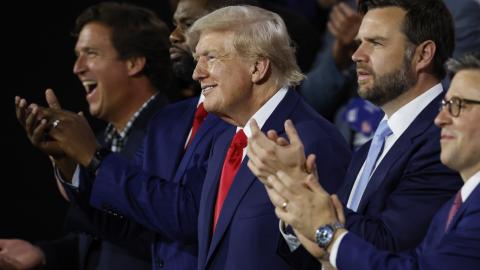The best advice for todays investors may have been penned some 350 years ago by the poet Robert Herrick, Gather ye rosebuds while ye may, . . . this same flower that smiles today, tomorrow will be dying. The American economy looks set for robust growth this quarter and next. After that, many experts are saying that the outlook is not quite so bright.
The economy grew at an annual rate of 4.1 percent in the final quarter of last year, and will probably grow a bit faster than that in the first half of this year. Sales of new homes last month were up 24.4 percent over the February 2003 total, reducing the inventory of unsold homes to a level so low that housing construction will remain strong. Sales of capital goods are up, suggesting continued improvement in the manufacturing sector. Consumers continue to spend. Little wonder that most economists are relaxed about the economys performance through the second quarter.
But many of these same economists are unwilling to project that cheerful scenario further into the year, and some are predicting that we will see a decline of at least 10 percent in share prices as the problems that are waiting around the corner become more visible to investors.
Start with oil prices. Until last week, when a jump in U.S. inventories eased immediate concerns about further rises in crude oil prices, those prices seemed on a one-way escalator. Whether they will rise further will depend in part on what the OPEC cartel decides when it meets later this week, but it seems safe to conclude that no major softening is in sight. Producing countries want to make up for the reduced purchasing power of the dollars they are getting for their oil, and are convinced that if they fail to carry out planned production cuts prices will fall by at least $7 per barrel.
Higher crude prices mean higher gasoline prices. But right now other factors are driving up pump prices. Inventories of gasoline are low, demand is growing at a rate of close to 5 percent, many refineries are shut down for maintenance, and air-quality rules require different gasoline formulations in different cities, limiting the ability of refiners to move gasoline to supply-short areas.
Government economists say that every 10 percent increase in crude oil prices can reduce the rate of growth in GDP by about 0.1 percent. Since prices this year are up by about 15 percent, the increases so far experienced shouldnt have a major impact0.2 percent at moston the economy.
Thats what the economic modelers say. But they arent counting on the psychological effect of the rise in gasoline prices to more than $2 per gallon for premium-unleaded gasoline in many parts of the country.
Consumers see the higher prices every time they fill up their tanks. A typical consumer drives about 10,000 miles per year, and consumes about 500 gallons of gasoline. So a 50-cent-per-gallon price jump costs a two-car family $500 per yeardouble that for owners of big sports-utility-vehicles that guzzle more gasoline and are typically driven more miles.
It is not only gasoline prices, and their effect on consumers pocketbooks, that has economists nervous about the second half of the year. The greatest short-term risks to the economy, according to the business economists who gathered in Washington last week for a meeting of the National Association of Business Economists, are a weak jobs market and a burgeoning federal deficit.
If the jobs market doesnt improve, consumers may become nervous. Not because the unemployment rate is unduly highit isntbut because those in work are being bombarded by Democratic politicians with scare stories about the possible outsourcing of their jobs, and might decide to rein in spending. More important, consumers are receiving some $50 billion in tax refunds this month and next, and will probably have spent whatever portion they plan to use for cars, clothes, flat-screen television sets, and digital cameras by the time that July 1 rolls around. That spending will add about 0.75 percent to the economys growth in the first six months, reckons Marc Sumerlin, a former White House economist who is now managing director of the Lindsey Group.
The end of that tax-rebate stimulus, combined with higher oil prices, might in combination shave about a full percentage point from second-half growth, lowering it to 3 percent-3.5 percent from its current rate. Worries about the jobs market might lower growth a bit more. Still, not a bad outlook, especially if business investment takes up the slack, as it well might.
But none of this back-of-the-envelope arithmetic accounts for the post-Madrid increase in the perceived geopolitical risk that raises the cost of capital and discourages business investment. Or for the effect of the simultaneous events scheduled for July 1: a huge troop rotation that might expose our troops to devastating attacks; the planned transfer of sovereignty to some Iraqi authority, a plan that might founder on the rocks of Shia opposition; the withdrawal of Spanish and possibly Polish troops from a key zone; and the arrival of scorching heat in an electricity-short Baghdad.
My own view is that the rosebuds we are gathering as spring approaches will not be dying come summer. The fabled resilience of the U.S. economy, amply demonstrated by its ability to survive the attacks on the World Trade Center and Pentagon, and to bounce back from the bursting of the dot-com bubble, will cope successfully with all of these problems. After all, Americans are wealthier now than they were before oil prices shot up, dot-com share prices fell, and terrorists attempted to disrupt the economy.
This article appeared in Londons Sunday Times on March 28, 2004.



















